While there is no one perfect tree that will benefit every homesteader, the mulberry tree has a lot to offer. If you’re looking for a tree that grows quickly, is low-maintenance, and will feed you and your animals, then the mulberry tree is for you.
There are a few different mulberry tree varieties, but the two most common in North America are:
White mulberry (M. alba) was brought to North America from Asia by British colonisers and has since naturalised. White mulberry was originally used in China for raising silkworms and continues to be used to feed silkworms and livestock.
Red mulberry (M. rubra) is the native to North America so may be a better choice depending on your region. It has successfully hybridized with the white mulberry.
The name doesn’t indicate the colour of the fruit. All mulberry trees produce berries from light red to dark red.
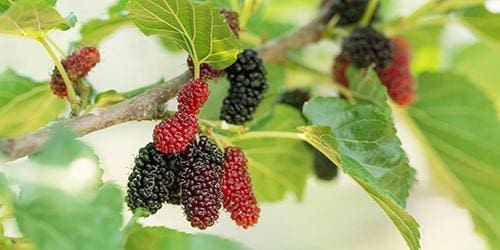
Why You Should Grow A Mulberry Tree:
Easy to Grow, Little Maintenance
There aren’t many trees that are this easy to grow. Mulberry trees grow 10 feet each year, to a total of 50 to 70 feet. They live for 75 years.
They transplant easily and they’re super low maintenance, tolerating drought and road salt. You don’t need to prune them. Let them grow into massive, berry-producing trees. In fact, pruning should only be used sparingly to remove dead or overcrowded branches during winter dormancy, as they’re prone to bleeding from cuts.
They also provide effective windbreaks and their thick foliage provides shade and cools down your yard.
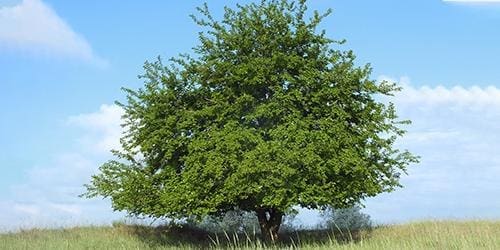
Highly Nutritious and Delicious Berries
Mulberry trees start producing berries early at 6 years of age and, with a long harvest period from June to September, are super prolific! You don’t need to worry about birds, insects, and animals eating your crop, as the mulberry tree will produce more than enough for all of you.
Harvesting is easy. Since berries fall from the tree when they’re ripe, all you need to do to harvest is to put tarps underneath.
Mulberry trees can be raised from seed or propagated from cuttings, but I recommend picking up a two-year-old tree from a local nursery. Most mulberries are female or male, so you need both to pollinate, but nurseries grow self-pollinating varieties. Plus you get a two-year head start on fruit production.
The berries have a sweet-tart flavour, kind of like grapefruit, and you can use them as a substitute for blackberries and raspberries.
They’re naturally high in pectin, so are great for making jam and jelly. You can also eat them fresh or dry them for the winter.
Even better, mulberries are rich in iron (a perfect supplement if you have low iron levels), Vitamin C, Vitamin K, calcium, magnesium, and other trace minerals. They’re high in fibre, so make an effective natural remedy for constipation.
They’re also high in antioxidants, and one study suggests that an isolated compound in mulberry juice can be used as a breast cancer treatment.
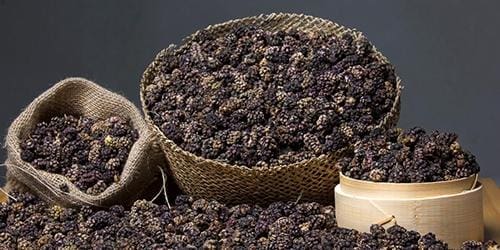
Durable, Rot-Resistant
Since mulberry trees grow quickly when they’re young, they’re a great tree to coppice either for firewood or to build with.
The wood is durable and rot-resistant, and the tree’s long pliable branches are perfect for weaving into baskets, fences, and screens, or providing stakes in the garden. You could even learn the fine art of making basket traps to fish with.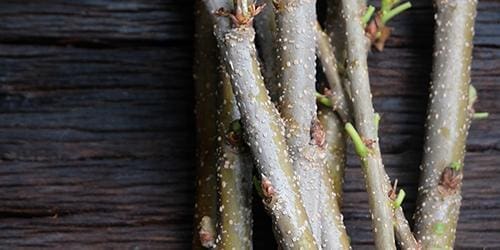
Livestock
The white mulberry tree was originally grown in China as the favourite food of silkworms, but they’re not the only ones who will enjoy the leaves. The leaves provide excellent winter fodder for ruminants like cattle, goats, and sheep. They have the same protein content as alfalfa, at 20% dry matter and 2005 study found that milk production increased in goats fed mulberry leaves.
Dry the leaves by leaving them in the sun for 3 to 5 days or turn them into silage by chopping the leaves in 2 or 3 cm long pieces, letting the leaves wilt in the sun, then adding 5% bran and 5% molasses. Store in plastic bags at room temperature for 56 days.
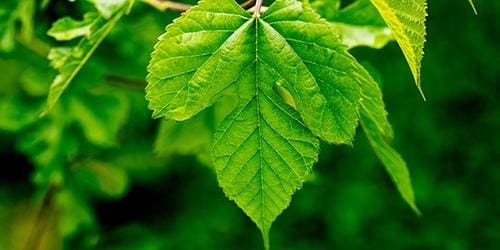
Natural Dye
If you’ve ever eaten fresh mulberries and come away with stained hands, you know that mulberries provide an effective and natural dye. Just make sure you plant mulberry trees away from flagstones, concrete and other light surfaces unless you like red splatters.
Ways to Make Money From Mulberry Trees:
Looking to make some extra money from your homestead? Here are a few ways mulberry trees can help.
Sell
Mulberry trees produce a lot of berries over the season, and dried mulberries can sell for more than $10/lb in North America. You can also turn the berries into a jam.
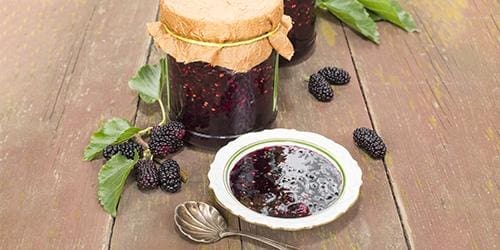
Furniture
Mulberry trees have durable, rot-resistant wood, which makes it desirable for any outdoor furniture. Indoors, the fine grain makes attractive interior finishes. You can use mulberry wood as a wood veneer to add beauty to other furniture pieces. The wood starts out bright yellow then fades to brown over the next few months. Just be warned: mulberry wood is unpredictable when treated with stains or finishes! The wood can warp or change into unexpected colors.
Dye
This could be especially profitable if you are raising sheep for wool and can spin that wool into yarn. Many knitters and crocheters will pay more for natural, organic, and hyper-local yarn.
Seedlings
As I mentioned above, you can propagate or graft from winter-hardy mulberry trees. Landrace plants, or plants that have adapted over the years to a particular location, are becoming more popular and more sought after. To do this, you’ll either want to find local “volunteers” (mulberry trees that grew without human intervention) or plant tons of seeds, select the best from the ones that survive, grow seeds from that tree, until you have a locally adapted tree.
Silkworms
While we tend to think of silkworms as local to Asia, there was a silkworm industry in the Eastern US, culminating in the Mulberry Craze of the 1830s. Production is labour-intensive and manufacturing requires skill mastery, but if you can find a market for locally-raised silk and you have a burning passion to raise silkworms, sericulture may be for you.
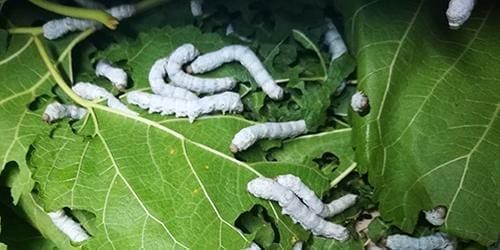
While mulberry trees come with some disadvantages, if you’re looking for one tree that can provide a windbreak and shade, feed you and your animals with highly nutritious food, provide wood for building outside or just to keep you warm, as well as provide a natural dye — then you may just want to plant yourself a mulberry tree.
You may also like:
How to Build a Smokehouse In Your Backyard (with Pictures)
What Happens If You Pour Honey Over Meat (Video)
18 Plants That Should Never Be Planted Together
When Did Independence Become Illegal?
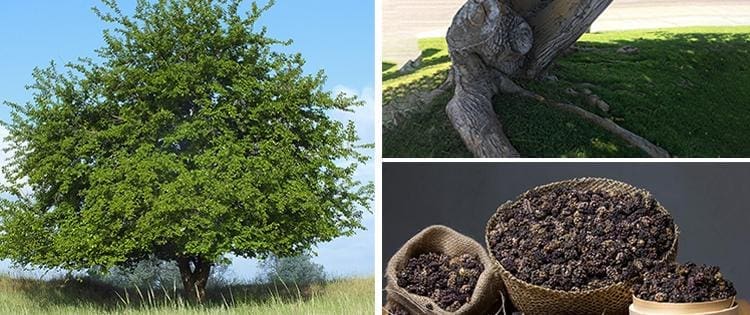








worst advice ever! Mulberry trees? are you nuts? its a tree weed. No way.. I’ll plant a paw paw tree in stead or honey berries..
You probably think that dandelions are weeds as well even though they provide SOOOOO much good for us!
Mulberry trees are great…
In my grandparents village all households had mulberry trees in their yards and were usually planted in such a way that half of the crown was over the chicken enclosure…chickens loves the berries ( as much as me I think 🙂 and the branches gives them shade in the summer month
)7p
Worst advice??? Smh. Are YOU crazy… Mulberry trees are amazing!!! I’ve got three and still planning on planting more. On a medicinal side-note, on top of everything this article says about mulberries, the berries are also great support to individuals with hypertension when eaten regularly. Just another piece of awesomeness of the mighty mulberry trees!!!
Thank you this was very interesting and helpful!
My Name is Karin G
thank you!
I grew up in a small rural town in NW CT. Some of my favorite memories are of the hours I spent in old man Leonard’s mulberry tree. My girl friend and I both had voracious appetites for books, fun and adventure. We would climb into the massive branches of that old tree and could lay on the gently upward-sweeping limbs that were wider than our slim bodies. We would lay there for hours reading books, chatting and devouring mulberries. I cried when they cut that tree down due to rot. I thanked it for the blessings it gave us and for the special memories.
I grew up in Brazil and I always remember the happiness when finding a mulberry tree. I will plant one as soon as I manage to buy a land and start my homestead. Love to all.
would be helpful if we knew its span and width of the growth and extended root system
Google. There r many varieties and different sizes. You can even get dwarf and grow them in a pot outside! Easier for smaller yards.
I wish you would have touched on the disadvantages, too…
I was wondering the same thing!
I have enjoyed this article and learned a great deal, which will be very useful when I start my own gardens and useful trees. When I saw the title of this article I was sure you would be writing about a couple of other trees I have read about. Specifically the Morinaga tree. It is called the most complete nutritional planting available. It has been highly recommended for poverty stricken third world countries because of the amazing nutritional value in most all of the tree. The Morinaga trees are the answer to hunger needs , nutritional needs: Solving problems with starvation around the globe. Don’t take my word for it, do your due diligence researching for yourself the positive impact this tree would have worldwide. I am now convinced that the Mulberry and the Maringa trees are both necessary for a well established homestead. NOTE: I’m a retired school teacher. English was my Bachelor Degree from Texas A & M Commerce. I have misspelled the trees a time or two, please forgive my laziness to correct my errors.
moringa not morinaga…good suggestion…
What are the disadvantages?